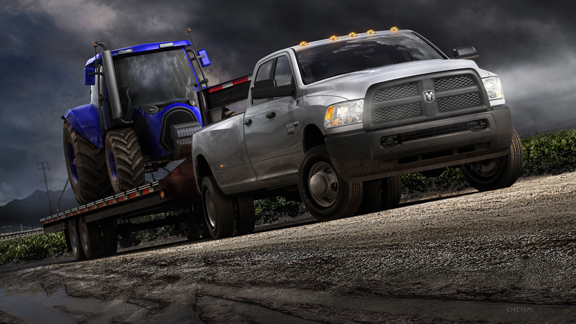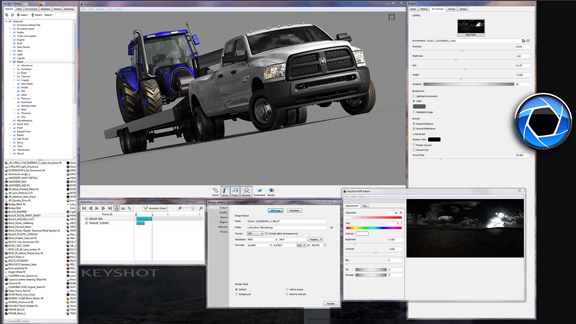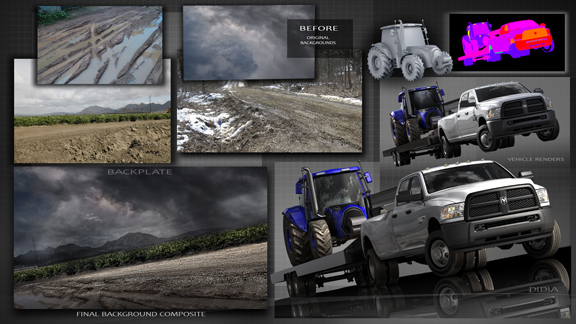
Doug Didia’s dramatic rendering of a Storm Trooper truck, done in KeyShot 5.1.
Latest News
January 8, 2015
 Doug Didia’s dramatic rendering of a Storm Trooper truck, done in KeyShot 5.1.
Doug Didia’s dramatic rendering of a Storm Trooper truck, done in KeyShot 5.1.Doug Didia, a 3D artist who currently works in the automotive industry, is a graduate of College for Creative Studies (1980 BFA Advertising) Detroit, MI, with 35 years of experience. To create photorealistic 3D images of vehicles for his clients, he uses a mix of Autodesk Maya, Luxion KeyShot, and Adobe Photoshop. So when he heard about the KeyShot Auto Render Competition (announced in October 2014), he knew he had a pretty good shot at the prizes. In November, when the winners were announced, Didia’s entry topped the list. Here, he shares his workflow and approach to rendering, using as example a rendering he did of a Storm Trooper truck on a mud-slicked road. His secret, as it turns out, is in the care with which he puts together the background image.
DE: Most of our readers work with CAD data, and many found it to be too rich, too detailed for a rendering program. Any tips on how to treat it so it can easily be managed in KeyShot?
Didia: The challenge to effectively reduce hundreds of Gigs of data down to three or four is huge. There are software available that will tessellate the geometry, but a lot of time and effort goes into manually cleaning and prepping many of the pieces where you just leave the bare minimum visible shell of the objects—A-sides only, B-sides removed. There is no “easy-button” way to end up with a manageable “vehicle data set.”
Speaking of managing large data, updates in KeyShot5 will allow “Instancing.” Imported vehicles can be duplicated and each one altered, within the same file, without slowing down my computing performance. I can now create a whole dealership parking lot of vehicles in every color and trim level with ease. Pretty cool! (For more on KeyShot instancing, read DE‘s previous blog post and watch a video review here.)
 Setting up the scene with the truck in KeyShot rendering program.
Setting up the scene with the truck in KeyShot rendering program.DE: What’s the difference between using a professional rendering and animation program like 3dx Max or Maya and using KeyShot?
Didia: It’s interesting to me that there is a misconception that KeyShot is somehow unprofessional. As an artist, complexity of the interface within 3D software scares the hell out of me. I want something fast, easy to use, that produces instant real-time high-quality results and allows me to play creatively without getting bogged down with a tsunami of menu calculations. If a piece of software takes five steps to do something vs. one step in another program and you achieve the same result, why would you want more steps?
Programs like Maya have a tremendous amount of capability and variables, but 95% of the time these variables are never touched. It’s overly complex if you’re just trying to do something simple and creative. Not only does KeyShot give me all of that, its stability and cost effectiveness are great too. I don’t need to remortgage my house to buy expensive video cards to make things move quicker. (KeyShot is CPU-driven, not GNU-dependent).
DE: Can you give me the specs of your PC?
Didia: It’s custom-built, with i7-4770K Quad-Core 3.5GHz CPUs (with Hyper-threading), 32GB RAM (Memory) and NVIDIA GPU. The sample image for Storm Trooper took about 3 hours to render at 5,000 x 2,664 pixels. I could have set the finished render up as high as 20,000 pixels if I wanted a wall wrap application.
 Doug Didia combines various photo sources to create the dramatic backdrop he needs.
Doug Didia combines various photo sources to create the dramatic backdrop he needs.DE: What do you use to combine various different elements (ominous sky, dirt tracks, and snowy-dusted road) into a single image for the Storm Trooper project?
Didia: I combined multiple photos to create an exquisite back plate that suits my layout or assignment needs. More to the point, I utilize 35 years of perspective drawing, painting, and composition experience, combined with honed skills in Photoshop to successfully achieve a natural environment or dramatic mood. People believe that by possessing Photoshop, it automatically makes them capable. Photoshop, like KeyShot, is just another tool that levels the playing field. When placed in the hands of a talented artist, a simple tool can generate amazing results.
DE: Are the materials you applied to the vehicle standard KeyShot materials? Did you tweak them or import your own?
Didia: They are standard materials. The shaders have some good options, adjustments, and textures that you can play with to get the desired effect you want. Creating a library of your favorite shaders over time allows you to grow with each job.
DE: Any tips for novice KeyShot users who are not animators or visual artists but primarily CAD designers?
Didia: KeyShot is not built for modeling. But you can use it throughout the product development process to make design decisions and quickly create variations of concepts. Don’t be afraid to just play. It’s a visualization tool; it’s up to you to push it to your advantage.
Subscribe to our FREE magazine, FREE email newsletters or both!
Latest News
About the Author
Kenneth Wong is Digital Engineering’s resident blogger and senior editor. Email him at [email protected] or share your thoughts on this article at digitaleng.news/facebook.
Follow DERelated Topics






